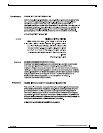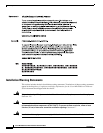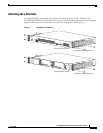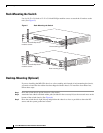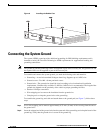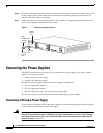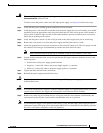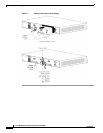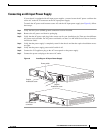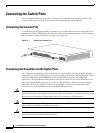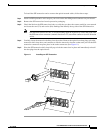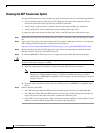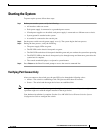
22
Cisco ME 6500 Series Ethernet Switch Installation Note
78-17360-02
Connecting the Switch Ports
Cleaning the SFP Transceiver Optics
For optical SFP transceivers, before making any optical connections, observe the following guidelines:
• Always keep the protective dust plugs on the unplugged fiber-optic cable connectors and the
transceiver optical bores until you are ready to make a connection.
• Always inspect and clean the LC connector end-faces just before making any connections.
• Always grasp the LC connector housing to plug or unplug a fiber-optic cable.
To inspect the optics and connect the fiber-optic cable to the SFP transceiver, follow these steps:
Step 1 Remove the dust plugs from the network interface cable LC connectors. Save the dust plugs for future
use.
Step 2 Inspect and, if necessary, clean the network cable LC connector’s fiber-optic end-faces. An inspection
and cleaning procedures document is available at the following url:
http://www.cisco.com/en/US/tech/tk482/tk876/technologies_white_paper09186a0080254eba.shtml
Step 3 Remove the dust plugs from the SFP transceiver optical bores and immediately attach the network
interface cable LC connector to the SFP transceiver.
Step 4 To connect 1000BASE-T SFP transceivers to a copper network, perform the following substeps:
Caution To comply with GR-1089 intrabuilding lightning immunity requirements, you must use grounded,
shielded, twisted-pair, Category 5 cabling.
a. Insert the copper network cable RJ-45 connector into the SFP transceiver connector.
Note When connecting to a 1000BASE-T-compatible server, workstation, or router, use four
twisted-pair, straight-through Category 5 cabling for the SFP transceiver port. When
connecting to a 1000BASE-t-compatible switch or repeater, use four twisted-pair, crossover
Category 5 cables.
b. Insert the other end of the network cable into an RJ-45 port on a 1000BASE-T-compatible target
device.
Step 5 Observe the port status LED:
• The LED turns green when the SFP transceiver and the target device have an established link.
• The LED turns amber while the SFP transceiver discovers the network topology and searches for
loops. This process takes about 30 seconds, and then the LED turns green.
• If the LED is off, the target device might not be turned on, there might be a cable problem, or there
might be a problem with the adapter that is installed in the target device.



